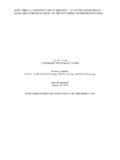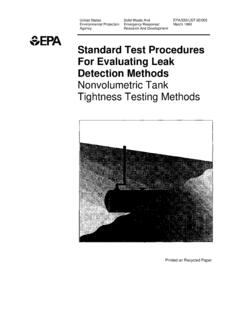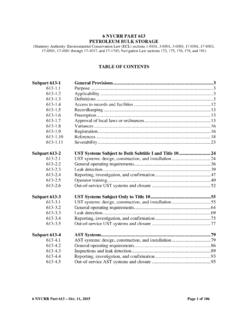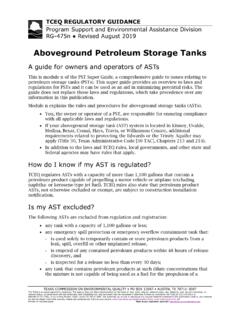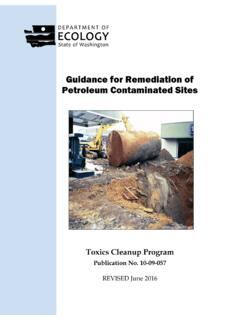Transcription of FAA Order 1050.15B - Fuel Storage Tank Systems at FAA ...
1 DEPARTMENT OF TRANSPORTATION Order . FEDERAL AVIATION ADMINISTRATION National Policy Effective Date: 02/01 / 18. SUBJ: fuel Storage Tank Systems at FAA Facilities I. Consistent w ith its mission to provide the safest, most efficient air transportation system in the world, the Federal Aviation Administration (FAA) must manage fue l Storage tank Systems ("tank Systems ") throughout their lifecycle in a manner that sign ificantly reduces the potential for env ironmental contamination and adverse risks to human health and the environment. 2. This Order establishes policy, delegates authority, and assigns responsibility for ensuring FAA tank Systems comply with Federal, state, and local requirements. 3. T his Order appl ies to all tank Systems owned and/or operated by FAA. All FAA personnel assigned tank system program management, budgeting, and compliance responsibilities must use this Order to manage tank Systems . 4. Each Line of Business (LOB) and Staff Office (SO) with tank system responsibilities must supplement this Order with policy, gu idelines, or procedures specifi c to its needs in a manner that is consistent with this Order .
2 5. Recognizing that program improvement is a vita l element in the program 's effectiveness and responsiveness to FAA ' s evolving needs, users are encouraged to offer suggestions to update and improve this Order through the use of FAA Form 1320-19, Directives Feedback In format ion . Bailey Edwards Assistant Admin istrator for Policy, International Affairs & Environment Distribution: Electron ic Initiated By: AEE-1. 02/01/18 Table of Contents Paragraph Page General 1-1. 1. Purpose of This Order .. 1-1. 2. Audience .. 1-1. 3. Where Can I Find This Order .. 1-1. 4. What this Order Cancels .. 1-1. 5. Explanation of Policy Changes.. 1-1. 6. Applicability .. 1-1. 7. Introduction to Tank Systems .. 1-2. 8. Summary of Regulatory Requirements .. 1-2. 9. Responsibilities .. 1-3. 10. Security and Risk Management Factors .. 1-4. Design, Installation, and Upgrade .. 2-1. 1. Introduction .. 2-1. 2. National Environmental Policy Act 2-1. 3. Preferred Tank Systems .. 2-1. 4. Tank system Requirements.
3 2-2. 5. Tank system Component Requirements .. 2-5. 6. Restoration of Grounds .. 2-9. Leak Detection .. 3-1. 1. Introduction .. 3-1. 2. Automatic Tank Monitoring .. 3-1. 3. Periodic Testing of Spill Prevention Equipment.. 3-3. 4. Alternative Methods of Leak Detection for 3-7. 5. Notification of Release.. 3-7. Operations and Maintenance .. 4-1. 1. Introduction.. 4-1. 2. Inspection Requirements .. 4-1. 3. Repair Requirements .. 4-2. 4. Release Detection Requirements .. 4-2. 5. Spill and Overflow Protection .. 4-3. 6. Spill Reporting .. 4-3. 7. Spill Prevention Control and Countermeasures Plan .. 4-3. 8. Facility Response Plan .. 4-6. Closure and Disposition .. 5-1. 1. Introduction .. 5-1. 3. Tank Closure .. 5-1. 4. Tank Disposal .. 5-3. ii 02/01/18 5. Restoration of Grounds .. 5-3. 6. Environmental Due Diligence Process .. 5-3. Recordkeeping .. 6-1. 1. Introduction .. 6-1. 2. Notification, Permitting, and Registration .. 6-1. 3. Operations, Maintenance, and Closure Recordkeeping.
4 6-2. Training .. 7-1. 1. Introduction .. 7-1. 2. General Tank system Training .. 7-1. 3. Spill Prevention Control and Countermeasures Training .. 7-1. 4. Facility Response Plan Training .. 7-2. 5. UST Operator Training .. 7-2. Administrative 8-1. 1. Distribution .. 8-1. 2. Background .. 8-1. 3. Authority to Change This Order .. 8-2. 4. Acronyms .. 8-2. 5. 8-2. Appendix A. Acronyms .. 1. Appendix B. 1. iii 02/01/18 General Information 1. Purpose of This Order . This Order establishes Federal Aviation Administration (FAA). policies, procedures, and responsibilities for new and existing underground Storage tanks (USTs), aboveground Storage tanks (ASTs), and pressure vessel Systems ; collectively known as tank Systems . This Order affirms FAA's commitment to managing tank Systems in a manner that significantly reduces the potential for environmental contamination and adverse risks to human health and the environment, while ensuring tank Systems comply with applicable Federal, state, and local requirements.
5 2. Audience. FAA employees and contractors involved with the installation, operation, maintenance, and support of tank Systems . 3. Where Can I Find This Order . This Order is available on the MyFAA employee website at and on the public website at 4. What this Order Cancels. This Order cancels FAA Order , fuel Storage tanks at FAA Facilities, dated 04/30/97. 5. Explanation of Policy Changes. This Order includes updated requirements associated with the design, installation, upgrade, operation, maintenance, monitoring, closure, removal and disposal of tank Systems . The Order updates the use of terminology, adds newer technologies, and removes old ones. This Order references regulations including the revised 40 CFR Part 280- 281 and 40 CFR Part 112. 6. Applicability. All FAA Lines of Business (LOBs) and Staff Offices (SOs) that own and/or operate tanks Systems must use this Order . a. Covered Tank Systems . Tank Systems that are owned and/or operated by FAA must meet the requirements of this Order if they meet either of the following criteria: (1) Contain fuel or other petroleum based products, regardless of the equipment supported; or (2) Contain regulated hazardous substances, as defined by 40 CFR Part and the Comprehensive Environmental Response, Compensation, and Liability Act (CERCLA).
6 B. Non-covered Tank Systems . This Order does not apply to the following tank Systems : (1) Potable water or stormwater collection Systems ;. (2) Oil/water separators discharging to sanitary sewers;. (3) Flow-through process tanks ; or 1-1. 02/01/18 (4) Transportable tanks . c. Exceptions. Wastewater treatment tank Systems at FAA facilities that are part of a wastewater treatment facility regulated under Section 402 or 307(b) of the Clean Water Act (CWA) are not covered by this Order . Wastewater collection Systems at FAA facilities that are not covered under the CWA are covered by this Order . 7. Introduction to Tank Systems . Tank Systems include: Storage tanks ( , main tanks , day tanks , etc.), flow control devices ( , pipes, hoses, pumps, valves, nozzles, dispensers), leak detection and inventory control devices ( , monitoring Systems ), and electronic/electrical system operation devices ( , controller boards, technician operations stations, switched relays). used to distribute, meter, or control the flow of regulated substances.
7 Tank Systems may be above ground or underground and are used to store fuel , other petroleum products, and regulated hazardous substances at manned and unmanned FAA facilities. They often store fuel for electrical generators, lubricating oils, building heater and boiler fuels, vehicle and aviation fuels, as well as regulated hazardous substances. Accidental release of these and similar materials could cause an adverse environmental impact, and result in personal injury and/or damage to property. 8. Summary of Regulatory Requirements. In response to the risk of accidental release, Federal, state and local authorities have established minimum requirements for the design, installation, operation, maintenance, closure, removal, and disposal of tank Systems . Additional requirements affecting tank system operations have been established under the jurisdiction of state and local building codes, fire protection codes, airport operating authority requirements, industry standards, and occupational safety and health acts.
8 This Order does not supersede Federal, state and local laws, which must be followed to ensure full compliance. Whichever law or regulation ( , Federal, state, local, this Order ) is more stringent takes precedence. As environmental laws and regulations change periodically, the most recent versions must be followed to ensure that the provisions included herein reflect current requirements. The Office of the Chief Counsel (AGC) must be consulted regarding any legal interpretive issues. a. underground Storage Tank (UST) Overview. FAA USTs must comply with Federal, state, and local laws and regulations . Federal regulations concerning USTs are contained in 40. Code of Federal regulations (CFR) Part 280, 40 CFR Part 281, and 40 CFR Parts USTs that store regulated substances ( , petroleum or hazardous substances), as defined in 40 CFR Part , are subject to these regulations . Hazardous wastes are regulated under Subtitle C of the Resource Conservation and Recovery Act (RCRA) and therefore are not covered by the UST regulations .
9 A complete version of Federal law that governs USTs is presented in 42 United States Code (USC) Chapter 82 Subchapter IX. This law incorporates amendments to Subtitle I of the Solid Waste Disposal Act (SWDA) and the UST provisions of the Energy Policy Act of 2005 (EPAct). b. Aboveground Storage Tank (AST) Overview. FAA ASTs must comply with the Spill Prevention, Control, and Countermeasure (SPCC) rule in 40 CFR Part 112. Recognizing that Federal AST requirements focus primarily on containment, the AST requirements in this Order 1-2. 02/01/18 exceed Federal requirements by specifying monitoring, testing, and validation of structural integrity requirements. c. Pressure Vessel Overview. Pressure vessels are not regulated by Federal statutes. FAA. pressure vessels must comply with the industry standard practices cited within this Order and state and local regulations and ordinances. In addition, Storage and handling of liquefied petroleum gases must be conducted in compliance with the Occupational Safety and Health Administration Standard, 29 CFR d.
10 Designation, Reportable Quantities, and Notification. In the event of a leak or spill, FAA personnel must follow reporting procedures required by Federal regulation and FAA. policy. 40 CFR Part provides a list of elements and compounds and hazardous wastes that are designated as hazardous substances and identifies the reportable quantities (RQ) for released hazardous substances. 40 CFR Part sets forth the notification requirements for the release of RQs of hazardous substances. State and local authorities also set RQs that must be followed, which may be more stringent than Federal RQ thresholds. Refer to Chapter 6 for additional information. 9. Responsibilities. a. Office of Environment and Energy (AEE). AEE is responsible for the overall FAA. environmental policy on tank Systems and coordination of that policy with FAA LOBs and SOs. AEE is responsible for the development of policies pursuant to EPA requirements, provision of advice and assistance to LOBs and SOs in development of guidelines and procedures for their program areas, interpretation of the policies established in this Order , and provision of assistance to responsible officials in the FAA concerning changes in EPA policies relative to tanks Systems .










